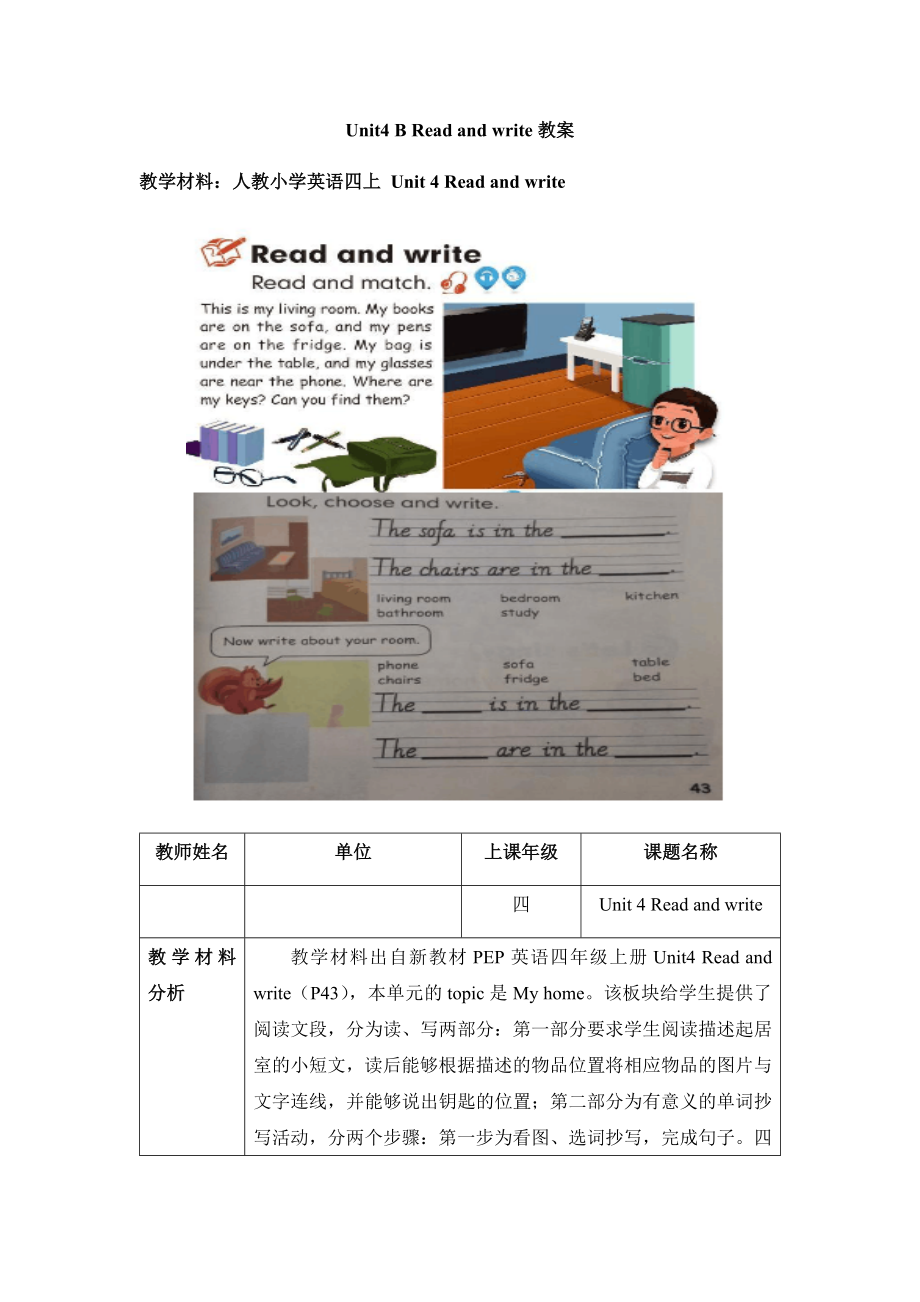《四年級上冊英語教案-Unit 4 My home PB Read and write 人教PEP版》由會員分享,可在線閱讀�����,更多相關《四年級上冊英語教案-Unit 4 My home PB Read and write 人教PEP版(7頁珍藏版)》請在裝配圖網上搜索�����。
1����、Unit4 B Read and write教案
教學材料:人教小學英語四上 Unit 4 Read and write
教師姓名
單位
上課年級
課題名稱
四
Unit 4 Read and write
教學材料分析
教學材料出自新教材PEP英語四年級上冊Unit4 Read and write(P43),本單元的topic是My home���。該板塊給學生提供了閱讀文段�,分為讀�����、寫兩部分:第一部分要求學生閱讀描述起居室的小短文���,讀后能夠根據描述的物品位置將相應物品的圖片與文字連線,并能夠說出鑰匙的位置����;第二部分為有意義的單詞抄寫活動,分兩個步驟:第一步為看圖、選詞
2�����、抄寫,完成句子�。四線格的句子均為對話及閱讀部分強化學習過的核心句型�����。第二步為個性化書寫活動,要求學生根據自己家里居室的布置情況完成句子�。
教學設計說明
本節(jié)課是一節(jié)閱讀寫作課。教學中主要以描述房間里有哪些物品�,這些物品分別在哪里為主線��,以The … is … the ... 和The … are … the …為主要描述句型���。先讓學生對我家的客廳進行語言點的滾動輸出,然后進入文本�,通過讀文�����、讀圖對文本進行多層次閱讀��,進一步鞏固了本節(jié)課的描述性語言,最后用已學的知識來描述同學的房間����,自己的房間����,小組合作將討論的結果作好記錄���,真正達到語用的目的�。
教學內容確定
Read and write
3����、
This is my living room. My books are on the sofa, and my pens are on the fridge. My bag is under the table, and my glasses are near the phone. Where are my keys? Can you find them?
教學目標定位
知識目標:
1. 能夠讀懂理解書上的小短文��,完成圖片與文字的連線以及描述鑰匙位置的任務����。
2. 能按意群和正確的語音、語調朗讀文本���。
3. 確區(qū)分is和are的用法�����。
4. 能說一說����、寫一寫同學的房間和自己的
4��、房間���。
能力目標:
學生能根據實際情況描述自己或他人的房間(living room; study; bedroom)。
情感目標:
引導學生學會收拾屋子����、把物品擺放整齊����,養(yǎng)成良好的生活習慣�。
教學重點難點
教學重點:
學生能理解短文�,并做相應練習�。
教學難點:
口頭描述后如何將書寫落實到位����。如何幫助學生理解is和are的區(qū)別����,并能在句子中正確運用。
板書設計
PEP Book3 Unit4 Read and write
sofa toy 1. —Where is the …? photos flowers
TV table
5���、 —The … is … the … keys glasses
box fan 2. —Where are the …? pictures
piano bag —The … are … the …
教學設計
教學步驟
教師活動
學生活動
建議說明
Pre-reading
1. Greeting.
2. Today, I’m your new teacher. Do you want to know more about me?
3. T: I live …. Look! This
6、is my home. Do you want to visit my house?
4. T: This is my living room. How do you think about my room?
5. T: What do you see in my living room?
T: Where is the TV? (Point to the sentence pattern, let children know which word can be used with “is”, and which can be used with “are”.)
6.
7�����、T: But one day, I can’t find my glasses. Can you find them?
7. T: Look! My glasses are in the box.
T: I can find my glasses. Can you find the glasses for Wu Yifan? Where are Wu Yifan’s glasses? Can you find them? Open your books and turn to page 43, find the answer by reading the pa
8���、ssage.
2. S: Ask questions. S1: What’s your name?
S2: What colour do you like?
S3: Where do you live?
4. S1: It’s beautiful. S2: It’s big and clean.
5. S: I see a TV.
S: I see some flowers.
The TV is on the wall.
The flowers are on the table.
6. S: Maybe the glasse
9�����、s are under the table. S: Glasses, glasses. Where are they? Find them, find them. I can find them.
通過引導學生問老師問題來引出我的家,進入客廳后就引導學生用:I see …的句型進行小組討論�����,用已知的內容來描述我的客廳里有什么���。當學生說出某件物品的時候�,教師開始追問Where …?引出本節(jié)課的描述性句型,通過和學生的一問一答不斷強調is 和are的區(qū)別�����。
最后創(chuàng)設一個小情境�����,讓學生幫忙找自己的眼鏡�����,用Maybe the glasses are ….的句型
10����、來找����,對再一次鞏固本節(jié)課的描述性句型����。同時在這個環(huán)節(jié)滲透Can you find them��?為接下來文本的教學作好充分準備。讀前教學所有的語言輸出都是在一個個真實的情境中進行的�,教師有引導,學生有討論�����、有猜測��、舊知新知滾動輸出����。
While-reading
1. Where are the glasses? Can you find them?
2. Present the main sentence pattern from the passage.
3. We can find these things by reading the words. But can you
11��、 find the keys by reading the words too?
Where are the keys? Can you find them?
1. S: Read and circle the answer.
S: Find the phrases by reading the passage.
2. Ask “where” questions. But he can’t…
3. S: Find the keys by reading the picture.
4. Read and match. 5. Listen and point.
12�、
初讀文本��,找出Wu Yifan的眼鏡在哪里,并圈出答案����。再讀文本,找出其他物品在哪里����?并圈出相關文字����。
看答句���,模仿課件用where來提問����,將原文中描述性的句子就問答句,幫助學生更好地進行語言交流�。
Post-reading
4. T: My living room is clean. How about Wu Yifan’s living room?
5. How about your classroom?
So, let’s work together, put away the things, OK?
6. Wow! … is cleaning th
13����、e blackboard. … is sweeping the floor. … is clean up his desk. Look! How is our classroom, now?
7. Here is a study. Whose study is it?
4. Try to describe the room.
8. Here comes a living room.
9. Read the picture carefully, then try to write a passage.
S: It’s not clean.
S: It’ not clean n
14���、either.
S: The ball is on the desk. I can put away the ball in the case.
The rulers are on the desk. I can put away the rulers in the pencil box.
S: It’s clean and nice!
We like the classroom!
S: Describe the room in the front.
S: Discuss and write.
Finish the … writing sheet, then
15����、show the sheet.
通過聽讀����、跟讀加強學生的朗讀訓練�。
從文本引申到自己的教室,很亂�,開始情感鋪墊,怎么樣才能讓教室變得干凈整潔���?大家一起來打掃。Put away是新加入的語言點��,課件上有中文注釋��,并通過一首歌曲讓學生理解會讀�。整理后,教室變得整潔漂亮了�,用勤勞的雙手為自己創(chuàng)造更美的環(huán)境。
語用及書寫分三個階段:
一��、小組討論說一說書房里有什么����,東西分別在哪里。并以小組的形式上來做口頭匯報����,初步利用情境展開語用練習�。
二����、獨立完成看圖仿寫��。
三、看圖合作完成短文的書寫���,并將學生寫好的磁條貼在黑板上,一起批改�,讓學生自己來發(fā)現書寫中出現的錯誤,并及時糾正���。
Homework
1. Read the passage on P43 fluently.
2. Talk about your room with the sentence patterns.
3. Finish “Homework sheet”. Write 3 sentences about your room. You can write more if you like.
 四年級上冊英語教案-Unit 4 My home PB Read and write 人教PEP版
四年級上冊英語教案-Unit 4 My home PB Read and write 人教PEP版

